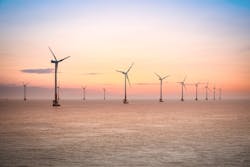Siemens Energy Transmission System Complements Chinese Offshore Wind Project
Siemens Energy commissioned an eco-friendly power transmission system complementing one of China’s largest offshore 8 MW wind turbines.
The system consists of a SF6 (sulfur hexafluoride)-free gas-insulated high-voltage switchgear (GIS) called 8VM1 Blue GIS and a liquid-immersed distribution transformer with ester fluid. It is part of a demo project by Shanghai Electric, located at Shantou Haojiang onshore Industrial Park on the east coast of Guangdong, South China.
“The growing power demand requires a new generation of wind power plants equipped with innovative technologies. Our SF6-free switchgear and our synthetic-ester transformer are contributing to the concept of an integrated clean energy solution. This demo project demonstrates true technology leadership and we are proud to be at the forefront with our sustainable product portfolio,” says Beatrix Natter, Executive Vice President Transmission at Siemens Energy.
The wind turbine generator is the first to run on 66 kilovolt (kV) in China. The 8VM1 Blue GIS was specifically developed to enable higher voltage levels in wind turbines and is also the first Blue GIS operating in China. It utilizes vacuum interrupters for switching functions and "clean air" as the insulation medium (industrially purified air) representing an environmentally friendly alternative to the potentially climate-harming insulating gas SF6. The 8VM1 Blue GIS can be installed inside a wind tower or a transition piece thanks to its wind turbine application adopted compact and lightweight design – even with clean air insulation.
Just like the switchgear, the transformer of type FITformer REN was developed to operate at a grid voltage level of 66 kV for wind turbine applications. The 8.8 MVA transformer is filled with ester biodegradable insulation fluid, an environmentally friendly and operationally safe alternative to conventional mineral oil. Its compact size and light weight allow the transformer to be installed inside the wind turbine’s nacelle.
The switchgear and transformer designs have been optimized to hold up under the hostile conditions of offshore applications and to keep the maintenance demand as low as possible.
